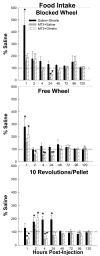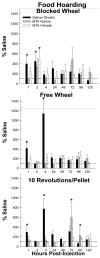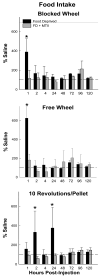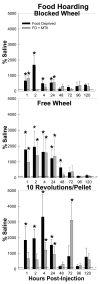MTII attenuates ghrelin- and food deprivation-induced increases in food hoarding and food intake
- PMID: 17826779
- PMCID: PMC2121140
- DOI: 10.1016/j.yhbeh.2007.07.014
MTII attenuates ghrelin- and food deprivation-induced increases in food hoarding and food intake
Abstract
Food deprivation triggers a constellation of physiological and behavioral changes including increases in peripherally-produced ghrelin and centrally-produced agouti-related protein (AgRP). Upon refeeding, food intake is increased in most species, however hamsters primarily increase food hoarding. Food deprivation-induced increases in food hoarding by Siberian hamsters are mimicked by peripheral ghrelin and central AgRP injections. Because food deprivation stimulates ghrelin as well as AgRP synthesis/release, food deprivation-induced increases in hoarding may be mediated by melanocortin 3 or 4 receptor (MC3/4-R) antagonism via AgRP, the MC3/4-R inverse agonist. Therefore, we asked: Can a MC3/4-R agonist block food deprivation- or ghrelin-induced increases in foraging, food hoarding and food intake? This was accomplished by injecting melanotan II (MTII), a synthetic MC3/4-R agonist, into the 3rd ventricle in food deprived, fed or peripheral ghrelin injected hamsters and housed in a running wheel-based food delivery foraging system. Three foraging conditions were used: a) no running wheel access, non-contingent food, b) running wheel access, non-contingent food or c) a foraging requirement for food (10 revolutions/pellet). Food deprivation was a more potent stimulator of foraging and hoarding than ghrelin. Concurrent injections of MTII completely blocked food deprivation- and ghrelin-induced increases in food intake and attenuated, but did not always completely block, food deprivation- and ghrelin-induced increases in food hoarding. Collectively, these data suggest that the MC3/4-R are involved in ghrelin- and food deprivation-induced increases in food intake, but other neurochemical systems, such as previously demonstrated with neuropeptide Y, also are involved in increases in food hoarding as well as foraging.
Figures




Similar articles
-
NPY Y1 receptor is involved in ghrelin- and fasting-induced increases in foraging, food hoarding, and food intake.Am J Physiol Regul Integr Comp Physiol. 2007 Apr;292(4):R1728-37. doi: 10.1152/ajpregu.00597.2006. Epub 2007 Jan 4. Am J Physiol Regul Integr Comp Physiol. 2007. PMID: 17204592 Free PMC article.
-
AgRP knockdown blocks long-term appetitive, but not consummatory, feeding behaviors in Siberian hamsters.Physiol Behav. 2018 Jun 1;190:61-70. doi: 10.1016/j.physbeh.2017.10.008. Epub 2017 Oct 12. Physiol Behav. 2018. PMID: 29031552 Free PMC article.
-
PYY(3-36) into the arcuate nucleus inhibits food deprivation-induced increases in food hoarding and intake.Peptides. 2013 Sep;47:20-8. doi: 10.1016/j.peptides.2013.05.005. Epub 2013 Jun 29. Peptides. 2013. PMID: 23816798 Free PMC article.
-
Peripheral ghrelin injections stimulate food intake, foraging, and food hoarding in Siberian hamsters.Am J Physiol Regul Integr Comp Physiol. 2005 Mar;288(3):R716-22. doi: 10.1152/ajpregu.00705.2004. Epub 2004 Dec 2. Am J Physiol Regul Integr Comp Physiol. 2005. PMID: 15576659
-
Neural and hormonal control of food hoarding.Am J Physiol Regul Integr Comp Physiol. 2011 Sep;301(3):R641-55. doi: 10.1152/ajpregu.00137.2011. Epub 2011 Jun 8. Am J Physiol Regul Integr Comp Physiol. 2011. PMID: 21653877 Free PMC article. Review.
Cited by
-
Physiological mechanisms for food-hoarding motivation in animals.Philos Trans R Soc Lond B Biol Sci. 2010 Mar 27;365(1542):961-75. doi: 10.1098/rstb.2009.0225. Philos Trans R Soc Lond B Biol Sci. 2010. PMID: 20156819 Free PMC article. Review.
-
Central ghrelin increases food foraging/hoarding that is blocked by GHSR antagonism and attenuates hypothalamic paraventricular nucleus neuronal activation.Am J Physiol Regul Integr Comp Physiol. 2016 Feb 1;310(3):R275-85. doi: 10.1152/ajpregu.00216.2015. Epub 2015 Nov 11. Am J Physiol Regul Integr Comp Physiol. 2016. PMID: 26561646 Free PMC article.
-
Anti-ghrelin Spiegelmer inhibits exogenous ghrelin-induced increases in food intake, hoarding, and neural activation, but not food deprivation-induced increases.Am J Physiol Regul Integr Comp Physiol. 2013 Aug 15;305(4):R323-33. doi: 10.1152/ajpregu.00097.2013. Epub 2013 Jun 26. Am J Physiol Regul Integr Comp Physiol. 2013. PMID: 23804279 Free PMC article.
-
Third ventricular coinjection of subthreshold doses of NPY and AgRP stimulate food hoarding and intake and neural activation.Am J Physiol Regul Integr Comp Physiol. 2012 Jan 1;302(1):R37-48. doi: 10.1152/ajpregu.00475.2011. Epub 2011 Oct 19. Am J Physiol Regul Integr Comp Physiol. 2012. PMID: 22012701 Free PMC article.
-
Role of ghrelin in the pathophysiology of eating disorders: implications for pharmacotherapy.CNS Drugs. 2012 Apr 1;26(4):281-96. doi: 10.2165/11599890-000000000-00000. CNS Drugs. 2012. PMID: 22452525 Review.
References
-
- Ariyasu H, Takaya K, Tagami T, Ogawa Y, Hosoda K, Akamizu T, Suda M, Koh T, Natsui K, Toyooka S, Shirakami G, Usui T, Shimatsu A, Doi K, Hosoda H, Kojima M, Kangawa K, Nakao K. Stomach is a major source of circulating ghrelin, and feeding state determines plasma ghrelin-like immunoreactivity levels in humans. J Clin Endocrinol Metab. 2001;86:4753–4758. - PubMed
-
- Asakawa A, Inui A, Kaga T, Yuzuriha H, Nagata T, Ueno N, Makino S, Fujimiya M, Niijima A, Fujino MA, Kasuga M. Ghrelin is an appetite-stimulatory signal from stomach with structural resemblance to motilin. Gastroenterology. 2001;120:337–345. - PubMed
-
- Bartness TJ. Food hoarding is increased by pregnancy, lactation and food deprivation in Siberian hamsters. Am J Physiol. 1997;272:R118–R125. - PubMed
-
- Bartness TJ, Clein MR. Effects of food deprivation and restriction, and metabolic blockers on food hoarding in Siberian hamsters. Am J Physiol. 1994;266:R1111–R1117. - PubMed
-
- Bartness TJ, Day DE. Food hoarding: a quintessential anticipatory appetitive behavior. Progress in Psychobiology and Physiological Psychology. 2003;18:69–100.
Publication types
MeSH terms
Substances
Grants and funding
LinkOut - more resources
Full Text Sources

